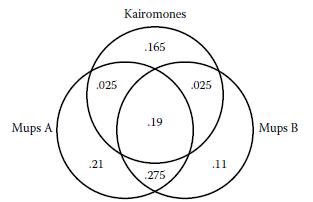Refer to the Cell (May 14, 2010) study of the chemical signals of mice, Exercise 3.18. Recall
Question:
Refer to the Cell (May 14, 2010) study of the chemical signals of mice, Exercise 3.18. Recall that lab mice were exposed to odors (Mups) from rodent species A, odors from rodent species B, and kairomones (from a cat). The Venn diagram showing the proportion of cells that chemically responded to each of the three odors is reproduced below. Given that a lab mouse responds to the kairomone, how likely is it to also respond to Mups A? Mups B?

Data from Exercise 3.18
The ability of a mouse to recognize the odor of a potential predator (e.g., a cat) is essential to the mouse’s survival. The chemical makeup of these odors — called kairomones — was the subject of a study published in Cell (May 14, 2010). Typically, the source of these odors is major urinary proteins (Mups). Cells collected from lab mice were exposed to Mups from rodent species A, Mups from rodent species B, and kairomones (from a cat). The accompanying Venn diagram shows the proportion of cells that chemically responded to each of the three odors.
Step by Step Answer:

Statistics For Engineering And The Sciences
ISBN: 9781498728850
6th Edition
Authors: William M. Mendenhall, Terry L. Sincich





